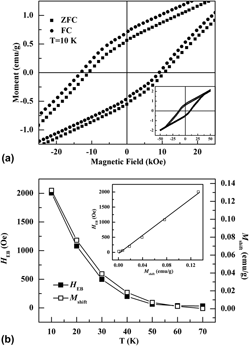Published online by Cambridge University Press: 16 September 2015

NiCr2O4/Cr2O3 system with ferrimagnetic spinel and antiferromagnetic transition metal oxide has been firstly synthesized by a chemical co-precipitation method. Magnetic measurements on this system also exhibit the exchange bias (EB) and training effect for the first time. EB effect with evident shift of coercive field and remnant magnetization can be detected at low temperature after field cooling from 350 K. The EB field can reach about 2037 Oe and the magnetization shift is as large as 0.129 emu/g at 10 K. Furthermore, EB effect recedes gradually with temperature increasing and disappears at about 70 K. In this process, EB field decreases with a linear dependence on the magnetization shift. This EB behavior is discussed according to the disordered regions existed at the interface between NiCr2O4 and Cr2O3. In addition, we have analyzed the training effect, which indicates the coexistence of two distinct forms of training mechanism during cycle procedure. One is concerned with an athermal impact resulting in the abrupt single cycle training and the other is gradual reduction of EB field during the subsequent cycles due to the conventional thermal activation mechanism.
Contributing Editor: Michael E. McHenry